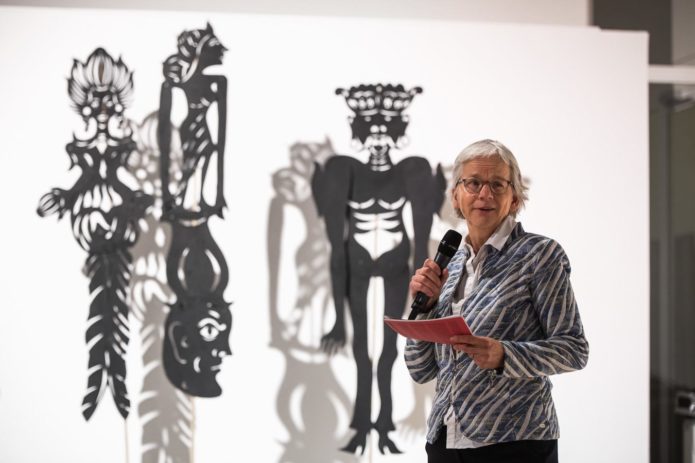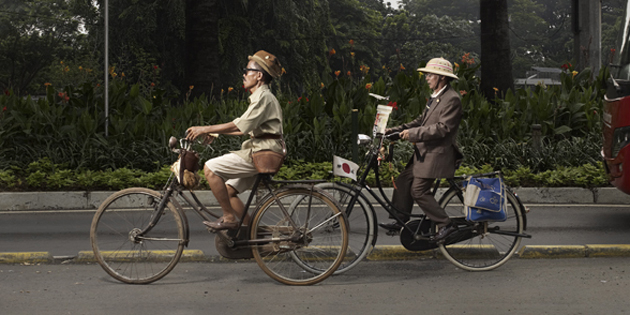 Colonial Nostalgia in het Tropenmuseum (17 maart 2011)
Colonial Nostalgia in het Tropenmuseum (17 maart 2011) Report: Colonial Nostalgia
On March 17, 2011 the Tropenmuseum organised in the Main Hall of the Royal Tropical Institute a symposium on Colonial Nostalgia. This was the perfect location for a debate on colonial nostalgia, with echoes of a glorious colonial past still resounding amongst its marble columns and elaborate decorations. As noted debate moderator Esther Captian, even the architecture boasts that “everything used to be better, even though we know this to be false.”
The occasion for the symposium was the launch of a series of works on the Tropenmuseum’s collection. Director Lejo Schenk proudly presented the Museum’s first two publications: Netherlands East Indies at the Tropenmuseum (edited by Janneke van Dijk and Susan Legêne) and Oceania at the Tropenmuseum (David van Duuren). Both volumes discuss the Museum’s collections, the context in which the collections were formed, and the history of the museum itself. These works will contribute to the spread of knowledge about the museum, but equally in the passing-on of expert knowledge within the museum itself. Lejo Schenk commented that, the other museum’s activities aside, such works have an important function in the sharing of heritage.
The second aim of the symposium was voiced by Wayne Modest, Head of Museum Affairs. His presentation extended the discussion beyond the book launch itself. Modest expressed the wish that an enticing and critical discussion would ensue about the collections but also about post-colonial processes operative in a nostalgically experienced past. He hoped that present and subsequent symposiums would contribute to the positioning of the Tropenmuseum in the 21st Century. The Museum’s publications discuss the historic role the Museum has played in the past. An inquiry into the present relevancy of this past will determine the future role the Museum likes to see for itself. Wayne Modest equally invited the audience to actively participate in the debate but also to be aware of role the past plays in that debate.
The volumes Netherlands East Indies at the Tropenmuseum and Oceania at the Tropenmuseum were presented by the editors, both former employees of the Museum. With passion for the trade, they gave an inside look into the two volumes, and, in this way, into the Museum’s rich past.
Janneke van Dijk, former curator of Photography and Image-culture at the Tropenmuseum was first to speak. Van Dijk started her presentation with an illustration that gave clear testimony of the relations between colonial subject and coloniser. Digital documentation techniques allowed for the forging of new links between the Museum’s various sub-collections. New perspectives and new categories were formed, among them the category of “colonial collections”. The link that previously existed between the colonial building and the collections housed therein had been lost in the Seventies and Eighties as a result of the then-current ideas. Ethnographic objects were put in storage, and the museum, as keynote speaker Henk Schulte Nordholt remarked, became “an entrance to the Third World”. A renewed interest, appearing in the Nineties, in the Museum’s own collection demanded that it take fuller account the object’s context. Indeed, each object has a number of stories to tell: Stories about who made it and who used it, but also stories about who collected it and how it has been presented over the years. The objects not only have stories of their own, but they also tell us about the colonial past of the Tropenmuseum itself. Janneke van Dijk illustrated this, using a series of old images of the Dutch Indies. Many a story is told in the works presented, but as she rightly commented: “Numerous objects still wait for theirs to be told.” Netherlands East Indies at the Tropenmuseum demonstrates the continued necessity to do research and to bear testimony.
Next spoke David van Duuren, former curator of the Oceanic and Historical Collections, who presented the volume Oceania at the Tropenmuseum. The Oceanic collection is one of world-wide renown. Using unique old photos David van Duuren recounted the story of the first expedition to reach the eternal snowy peaks of uninhabitable Papua New Guinea. Oceania at the Tropenmuseum discusses the collection’s origin but also speaks of the colonial settings in which it was formed. The oldest of the Museum’s collections ended up in the Artis collection, which was later added to that of the Colonial Museum. Illustrating his presentation with portraits of some of the important collectors we see the changing of the times. One of the collection’s founding-fathers was Sir Wellcome, British collector made rich by the sale of medicine during the First World War. Georg Tillmann donated his collection to the Tropenmuseum when forced to flee for England during the Second World War. The collections of Gijs Oudshoorn and Paul Wirz equally ended up at the Tropenmuseum. A tip-off by a Father led the museum to the paintings by Belgium missionary Petrus Vertenten, also added to the collection. Because the Oceanic collection contains many an exciting story the next volumes are already being eagerly anticipated.
After the break Wayne Modest’s wish was granted when speakers Henk Schulte Nordholt, Pamela Pattynama, and Susan Legêne each gave their reading of the notion of colonial nostalgia. Moderated by Esther Captain, historian, post-doctoral researcher at the NIOD, and programme director of the Centre for the Humanities at Utrecht University, the afternoon focussed on the question why the past often seems more pretty than the present, while we know this to be false.
Henk Schulte Nordholt, Head of the Department of Research at the KITLV and Full Professor of South-East Asia Studies at the Free University of Amsterdam noted that, although the phenomenon appears to be waning in The Netherlands, in Indonesia young people are reaching back to a nostalgic version of their own colonial past. Fancy dress parties, colonial-style design, and heritage walks help them re-evaluate a problematic period in history. Quite possibly it is a kind of counter-reaction to the one-sided history lesson taught to the young people of Indonesia. Yet the question remains whether such a reaction to a dominant view of history should be called nostalgic. Schulte Nordholt hence suggested the term “nostalgia-light”. These processes in Indonesia are interesting and appear to be running in parallel to the reflexive investigation becoming popular in The Netherlands.
After the introduction of nostalgia-light both Pamela Pattynama and Susan Legêne discussed the ambivalent nature of nostalgia. Pamela Pattynama, Honorary Professor of Indonesian Literature and Culture at the University of Amsterdam, focussed on post-colonial nostalgia. She emphasised the fact that nostalgia has a function to play in the formation of a “community of memory”. She demonstrated this for the Indonesian community in the Netherlands with its many different views on such nostalgic memories. Nostalgia is of a very contradictory and ambivalent nature. As Pattynama noted: “The danger lies in the venom of history.” Whereas post-colonial nostalgia is about accepting the past and (re)positioning oneself as a group within present-day society, Susan Legêne spoke about the desire to continue this past; that is, about neo-colonial nostalgia.
Susan Legêne, Professor of Political History at the Free University of Amsterdam, discussed how the exhibition Eastwards! Art, Culture & Colonialism, on permanent display at the Tropenmuseum since 2003, has been received. Reviewers judged the exhibition to be overly aesthetic, hence unable to effectively convey all the various aspects of the colonial past. Legêne noted that to say “It is too pretty” is not much of an argument; what critics mean to say is that the story is not good enough. As concerns Eastwards! critics should have focussed on the real choices made in order to discuss the colonial period of the Dutch Indies. Although the exhibition wants to allow the visitor to form his or her own version of these bygone days, the colonial days are, in effect, often not at all experienced as truly over. While nostalgia seems to be about a desire for a time that is past, the emotions and memories are not. These emotions continue to influence how we experience that past today. With the term neo-colonial nostalgia Legêne wanted to emphasise the fact that, although both exhibition and colonial nostalgia appear to be concerning a past that is truly past, it, in fact, shows us that the present is strongly informed by the past, and vice versa. It is not possible to present the colonial past in a way that is historically objective. As such Legêne warned us for neo-colonial nostalgia, both as concerns the exhibition and in general. Neo-colonial nostalgia is a wish to continue a certain image of the past. The emotions at play in this desire can even make it function as a racist cover.

Installatie photo of the exhibition Oostwaards!, Tropenmuseum, Amsterdam
Each in their own way the speakers expressed a warning about the subjective nature of nostalgia. It can be used to voice a counter-reaction, as do the young people of Indonesia. It can be used by communities of memory to reposition and redefine themselves, as is the case with the Indonesian community in the Netherlands. But it can also cover-up a dubious past with colourful images; to reduce the past to “a mere culture of food” (Lizzy van Leeuwen). That nostalgia is never free of sentiment became all the more clear during the question-round at the end. A good example was someone from the audience who asked about certain signs, allegedly posted next to swimming pools in the Dutch Indies, and that used to say: “Prohibited for dogs and natives”. Schulte Nordholt remarked that it is interesting to see how a (negative) colonial memory is able to persist, merely through the telling of stories, and in absence of any material evidence. It demonstrates that colonial nostalgia is of the subjective order; that memories dispute each other and undergo change, and that history and nostalgia go hand-in-hand. Nostalgia should not be ignored for its lack of objectivity. In light of the post-colonial processes that surround it the Tropenmuseum will have to actively engage with the various forms of colonial nostalgia.
The series of works about the Museum’s collection is an important initiative by the Tropenmuseum to explore and present the history of the colonial collections. The symposium offered an opportunity to discuss this history and its perception. Awareness of colonial nostalgia will aid the Museum in its quest to reposition itself in the 21st Century. Questions from the audience clearly showed that this should not take place in the objective space of academia, but through active dialogue with the audience; a dialogue in which nostalgia and history are close and often overlapping.
Proceedings: Rosalie Hans
Translation: Michael Kolkman
- Tropenmuseum - Amsterdam
Links
Colonial history / Photography / Indonesia / Museology /
Network

Wayne Modest
Head of the Research Center of Material Culture

Pamela Pattynama
Professor

